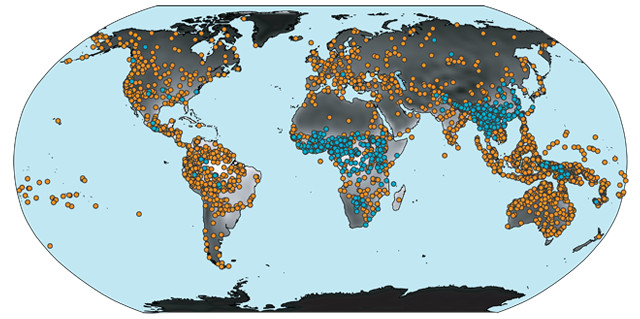
by Mary Caperton Morton Friday, April 3, 2015

The global distribution of tonal (blue dots) versus nontonal (orange dots) modern languages as identified in a new study. Credit: K. Cantner, AGI, after Everett et al., PNAS, 2015.
Humans today speak more than 6,500 languages, and thousands more dialects once spoken have gone extinct. Understanding how and why so many languages have evolved over human history has long been the work of linguists. Recently, however, the emerging field of geo-phonetics has begun looking into how geography — and perhaps climate — affects language. In a new study, researchers suggest that humidity and temperature, which can impact our ability to craft certain sounds, appear to have influenced the evolution of tonality in languages in different parts of the world.
“Languages change over time in similar ways to how cultures evolve over time,” says Sean Roberts, a linguist and statistician at the Max Planck Institute for Psycholinguistics in the Netherlands and an author of the study in Proceedings of the National Academy of Sciences. “There’s competition between words, just like there’s competition between genes,” he says. “Words are reproduced by people and they are either passed along over time or lost for one reason or another.”
To study how changing climates, or long migrations of peoples between different climates, may have influenced language evolution, researchers focused on the effect of cold, arid climates on humans’ ability to produce complex tonal sounds and pitch changes. These feats require precise manipulation of the vocal cords, and previously published laryngology studies have posited that some pitch distinctions are physically more difficult to make in cold, dry conditions.
Tonal languages make use of varying pitch in speech to designate distinct meanings for a single word. In Mandarin Chinese, for example, the most widely spoken tonal language, the word “ma” has several different meanings depending on how it is pronounced. In nontonal languages, like English, multiple meanings for a word are rarely distinguished using pitch variation, although some words are differentiated based on emphasizing different syllables — for example, “IN-clined,” meaning slanted or sloped, versus “in-CLINED,” meaning disposed.
“If complex tone is [counterproductive], the sounds will be selected against in certain climates, leading to [languages] losing — or perhaps never gaining — complex tonal contrasts,” Roberts says. To test their theory, the researchers plotted the geographic distribution of 3,700 modern languages — of which 629 were categorized as complex tonal languages and 3,071 were considered nontonal. The map revealed that tonal languages are prevalent in warm, humid regions, such as Southeast Asia, sub-Saharan Africa and the Amazon, whereas nontonal languages dominate in North America and Europe.
But just because a correlation exists between climate zones and a loosely-defined distinction between tonal and nontonal languages, that doesn’t necessarily imply a causal link, says Daniel Ezra Johnson, a linguist at Lancaster University in England. There could be other factors at play, Johnson says, “beyond the [climatic] variables that the authors have considered.” The idea that environment could influence language runs counter to many of the basic principles of linguistics, he says, which hold that a child should be able to learn to speak any language, regardless of the environmental conditions where he or she is raised. “I’m a little resistant to this evolutionary approach to language change in general, and to the specific idea that a factor like dry air is important enough to explain much about the distribution of tonal languages around the world.”
However, examples of environmental influences on the vocalizations and communication systems of other animals are prevalent, says Caleb Everett, an anthropological linguist at the University of Miami in Coral Gables and the lead author of the study. Whales evolved echolocation to communicate underwater, the rates at which crickets chirp vary with temperature, and the tone and pitch of bird vocalizations have been linked to the density of plant cover in a given species’ habitat. “It’s not clear to me why linguists have presumed that human language is not environmentally adaptive, given how environmentally adaptive the rest of our behavior is,” he says. Temperature and humidity are just two testable variables, he says, and there may be many more.
© 2008-2021. All rights reserved. Any copying, redistribution or retransmission of any of the contents of this service without the expressed written permission of the American Geosciences Institute is expressly prohibited. Click here for all copyright requests.